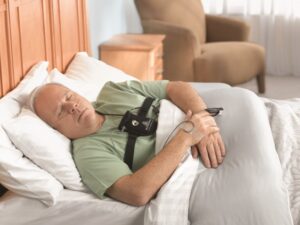Can Polysomnography be done at Home ?
What is a Polysomnography test?
 Polysomnography referred to as a sleep study, could be a comprehensive check won’t to diagnose sleep disorders. Can Polysomnography be done at Home ? polysomnography test in delhi ncr.
Polysomnography referred to as a sleep study, could be a comprehensive check won’t to diagnose sleep disorders. Can Polysomnography be done at Home ? polysomnography test in delhi ncr.
Polysomnography records your brain waves, the oxygen level in your blood, pulse rate and respiratory, with eye and leg movements throughout the study.
In addition to serving to diagnose sleep disorders, polysomnography could also be won’t to facilitate initiating or changing your treatment set-up if you’ve got already been diagnosed with a disorder.
Sometimes you will be able to do the sleep study reception. Home apnea testing uses a restricted variety of sensors to focus totally on diagnosing obstructive apnea (OSA).
Why it’s done?
Polysomnography monitors your sleep stages and cycles to spot if or once your sleep patterns are disrupted and why.
There are different kinds of home apnea check devices utilizing distinct mixtures of sensors. they often record your respiratory rate and flow, additionally with oxygen levels and pulse rate. One vogue incorporates info on blood vessel tone.
The normal method of falling asleep begins with a sleep stage referred to as non-rapid eye movement (NREM) sleep. throughout this stage, your brain waves, as recorded by electroencephalography (EEG), bog down significantly.
Your eyes do not retreat and forth apace throughout slumber, in distinction to later stages of sleep. when an hour or 2 of NREM sleep, your brain activity picks up once more, and rapid eye movement (REM) sleep begins.
You unremarkably undergo multiple sleep cycles an evening, sport between slumber and rem sleep in regarding ninety minutes. Sleep disorders will disturb this sleep method. Polysomnography tests in Delhi can be done at home.
Your doctor might advocate polysomnography if he or she suspects you have:
- Sleep apnea or another sleep-related respiratory disorder. during this condition, your respiratory repeatedly stops and starts throughout sleep.
- Periodic limb movement disorder. during this disorder, you involuntarily flex and extend your legs while sleeping. This condition is usually related to restless legs syndrome.
- Your expertise overwhelming daytime drowsiness and sudden attacks of sleep during this condition.
- REM sleep behaviour disorder in which you start acting out dreams as you sleep.
- Unusual behaviour throughout sleep. Your doctor might perform this check if you are doing uncommon activities throughout sleep, like walking and touring tons of regular movements.
- Unexplained chronic sleep disorder. If you systematically have hassle falling asleep or staying asleep, your doctor might advocate polysomnography.
Physicians will order a conveyable monitor that the patient can obtain from the workplace, find out how to control, and pull in for the Polysomnography test in Delhi. For in-home tests, patients generally affix simply a finger oxygen probe, a chest belt, and a nasal tube before attending to sleep.
 The top advantage of the home sleep study is that the in-home study prices but $600.
The top advantage of the home sleep study is that the in-home study prices but $600.
The requirements for an in-home sleep study are less cumbersome than for an in-lab study, and patients will schedule them for any convenient night.
As a result, no travel is concerned, in-home tests are particularly advantageous for the home-bound, elderly, or folks with several chronic diseases. Further, the in-home check is run within the comfort and privacy of the patient’s bed chamber.
And in what’s maybe the foremost necessary positive of in-home polysomnography for clinicians, in-home sleep studies have high accuracy in diagnosis folks with a big probability of getting OSA.
Yet the in-home sleep study has its drawbacks. this kind of study solely measures the guts rate, blood oxygen level, airflow, and respiratory patterns—not actual sleep.
Its results will underestimate the severity of the condition, and as a result, it will not generally live actual sleep time like an in-lab study does, throughout that graph sensors objectively live sleep length.And if a device falls off or becomes faulty, tech isn’t there to repair it; in these cases, patients might need repeat studies.
Because of this restricted scope, solely patients already assumed at high risk for moderate or severe sleep apnea ought to use the in-home possibility.
Folks with pre-existing conditions, like respiratory organ unwellness, hypoventilation, heart disease, or alternative sleep disorders, aren’t candidates for home testing.Polysomnography tests in Delhi can be done at home.